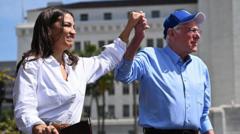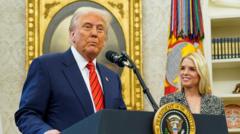The Democratic Party faces a crossroads with growing internal dissent and a quest for unity amidst challenges from the Trump administration and its own leadership.
What Next for Democrats? A Fragmented Path Forward

What Next for Democrats? A Fragmented Path Forward
Amidst discontent, Democrats grapple with their identity and direction
In Bakersfield, California, surprisingly filled to capacity for a rally, progressive icons Congresswoman Alexandria Ocasio-Cortez and Independent Senator Bernie Sanders ignited a fervor among local supporters disillusioned with the Democratic Party's response to President Trump's policies. This conservative area, a stark contrast to the party's typical strongholds, echoed the sentiments of enforced discontent: a cry for a stronger resistance. Attendees voiced their frustrations, with participants like 26-year-old Karla Alcantar lamenting the party's inefficacy in providing meaningful opposition to the current administration.
As Democrats struggle to present a unified front, their current disarray is palpable. Ideological divisions, generational rifts, and a lack of cohesive leadership have left many party members feeling powerless. Recent polling reveals that over half of Democrats believe their leaders are off track, intensifying calls for a more aggressive approach to opposing Republican policies.
Former Congressman Conor Lamb captures the urgency on the ground: “They want us to act with that level of urgency,” he stated, emphasizing the need for pragmatic, concrete changes that impact citizens directly. While Sanders and Ocasio-Cortez seek to redirect the party's focus toward economic grievances, some assert the necessity for broader community outreach. California Governor Gavin Newsom embodies this moderate approach, aiming to bridge gaps with ideological adversaries—though provocative moves, such as inviting controversial figures for public discussions, have met backlash within his party.
Debates about generational leadership are also prominent, as younger party figures like gun safety advocate David Hogg clash with established party strategists over the party’s future direction, calling for progressive ideas that resonate with wider audiences. As Democrats wrestle with their identity and voice in a polarized political landscape, rallies led by Sanders and Ocasio-Cortez serve as both a reflection of grassroots enthusiasm and a stark reminder of the need for action that resonates across diverse American communities.
In summary, as the Democratic Party finds itself at critical junctures of identity and strategy, the voices of constituents demand urgency and action—a collective push toward a decisive path forward. The question remains: can they find common ground to mount a successful opposition in the years ahead?
As Democrats struggle to present a unified front, their current disarray is palpable. Ideological divisions, generational rifts, and a lack of cohesive leadership have left many party members feeling powerless. Recent polling reveals that over half of Democrats believe their leaders are off track, intensifying calls for a more aggressive approach to opposing Republican policies.
Former Congressman Conor Lamb captures the urgency on the ground: “They want us to act with that level of urgency,” he stated, emphasizing the need for pragmatic, concrete changes that impact citizens directly. While Sanders and Ocasio-Cortez seek to redirect the party's focus toward economic grievances, some assert the necessity for broader community outreach. California Governor Gavin Newsom embodies this moderate approach, aiming to bridge gaps with ideological adversaries—though provocative moves, such as inviting controversial figures for public discussions, have met backlash within his party.
Debates about generational leadership are also prominent, as younger party figures like gun safety advocate David Hogg clash with established party strategists over the party’s future direction, calling for progressive ideas that resonate with wider audiences. As Democrats wrestle with their identity and voice in a polarized political landscape, rallies led by Sanders and Ocasio-Cortez serve as both a reflection of grassroots enthusiasm and a stark reminder of the need for action that resonates across diverse American communities.
In summary, as the Democratic Party finds itself at critical junctures of identity and strategy, the voices of constituents demand urgency and action—a collective push toward a decisive path forward. The question remains: can they find common ground to mount a successful opposition in the years ahead?




















